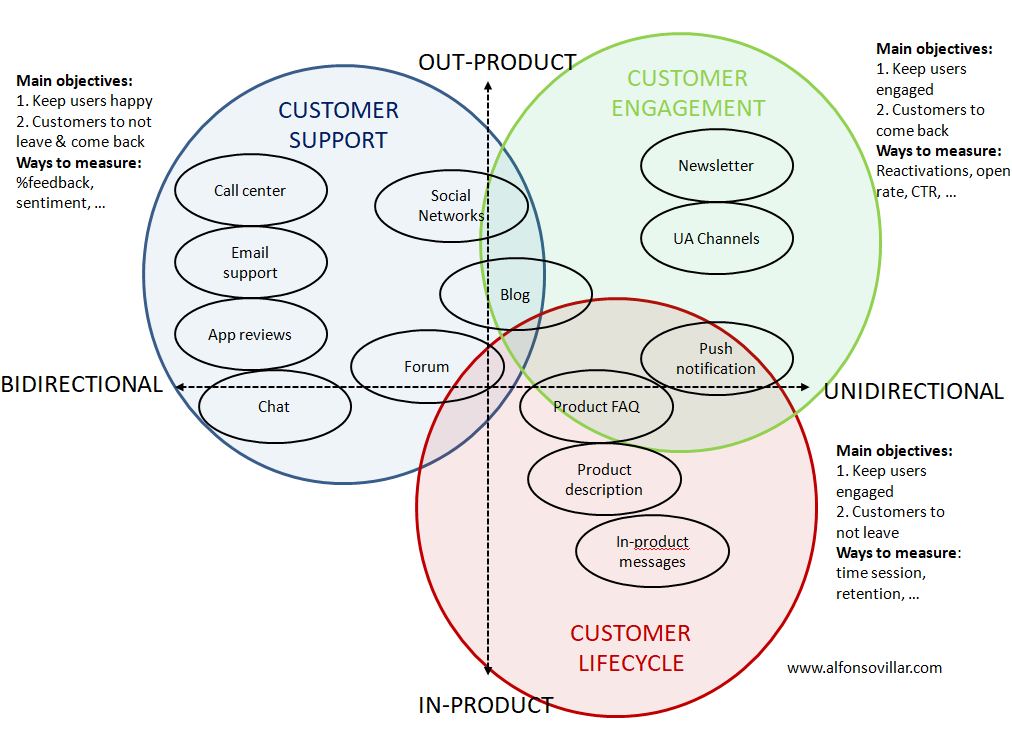 In any B2C business’s Marketing department based on direct communication within the customers the Marketing Manager manages the user acquisition channels. Moreover, the Customer Relationships Manager or CRM Manager manages the communication channels within the customers and final users with the final objetive to increase user retention and reduce customer churn.
In any B2C business’s Marketing department based on direct communication within the customers the Marketing Manager manages the user acquisition channels. Moreover, the Customer Relationships Manager or CRM Manager manages the communication channels within the customers and final users with the final objetive to increase user retention and reduce customer churn.
Furthermore, the CRM Manager should know all existing user communication channels, their context, objectives to achieve with each of them and how they are measured aligning them with the company’s marketing strategy.
The main contexts for the communication with the customers are engagement, customer support and communications for the customer lifecycle management.
Customer communication channels for engagement
While the product team is mainly responsible for achieving engagement, the CRM Manager could design different strategies to achieve increases in engagement through the use of different communication channels. These strategies should also be aligned with Product and Marketing strategies. For example, a newsletter can be used to inform customers about a product update, a push notification could include a promotion code or the company could use their blog or social networks to write about an event article for customers.
The main objectives for these communication channels are:
- Keep customers engaged.
- Getting customers to come back.
Metrics to evaluate these communication channels could be: number of reactivations, %reactivations by channel, open rate, click rate, etc. For example, with these metrics we could validate that 20% of our customers are repeating purchases through promotions published on the blog or that our customers are more involved interacting through push notifications rather than social networks.
Customer communication channels for the customer lifecycle.
These communication channels are used to optimize customer lifecycle. The CRM Manager is responsible for defining the appropiate communications at the right time into the customer’s life to optimise the conversion funnel. For example, when doing an online purchase you should receive an email confirmation with all purchase details or when you are experiencing a product for the first time you should receive different types of messages in order to improve your onboarding experience.
All of these communications are used to:
- Keep customers engaged.
- Get customers not to leave.
And they could be evaluated through the following metrics: session time, %drop-off by step, etc. For example, with these analysis we could set up configurations to encourage purchases at the moment the customer is more willing to buy.
Communication channels for customer support.
In addition, in any B2C business, there is always a customer support dedicated team, from call center, email, chat, etc. CRM Manager is responsible for defining all channels and customer care protocols for each case in order to align them with the company’s communication strategy. For example, when you send an email request to Amazon you instantly receive an “automatic-response” informing you when you will be supported. In a call center you are guided through questions depending on your problem, etc.
Main objectives for customer support are:
- Keep customers satisfied.
- Getting customers to come back and getting customers not to leave.
Possible measurement metrics could be: number of call entries, %entries by channel, satisfaction surveys, etc. For example, we could define that less of 1% of our customers are getting in touch with us to inform about problems or that 70% of the queries are related to incidents or complaints.
It is not possible to classify a communication channel for a given context as any channel could be used in any context and different purposes. For example, a push notification could be used in the context of engagement, customer support and lifecycle management at the same time. It is an issue for the CRM Manager to define the strategy and objectives for each communication channel.




